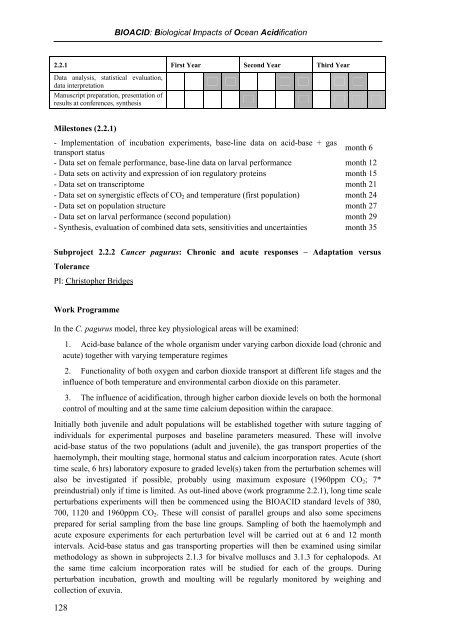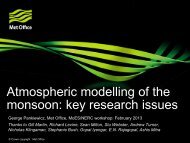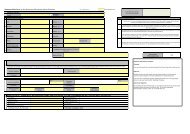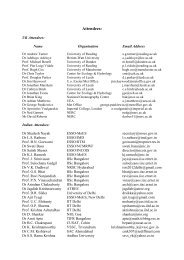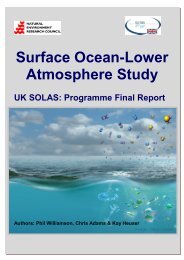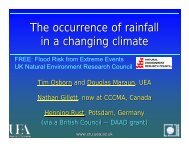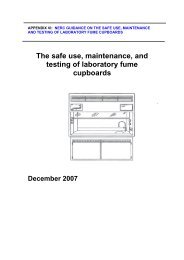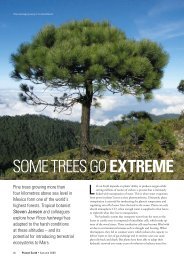BIOACID Programme - Natural Environment Research Council
BIOACID Programme - Natural Environment Research Council
BIOACID Programme - Natural Environment Research Council
You also want an ePaper? Increase the reach of your titles
YUMPU automatically turns print PDFs into web optimized ePapers that Google loves.
128<br />
<strong>BIOACID</strong>: Biological Impacts of Ocean Acidification<br />
2.2.1 First Year Second Year Third Year<br />
Data analysis, statistical evaluation,<br />
data interpretation<br />
Manuscript preparation, presentation of<br />
results at conferences, synthesis<br />
Milestones (2.2.1)<br />
- Implementation of incubation experiments, base-line data on acid-base + gas<br />
month 6<br />
transport status<br />
- Data set on female performance, base-line data on larval performance month 12<br />
- Data sets on activity and expression of ion regulatory proteins month 15<br />
- Data set on transcriptome month 21<br />
- Data set on synergistic effects of CO2 and temperature (first population) month 24<br />
- Data set on population structure month 27<br />
- Data set on larval performance (second population) month 29<br />
- Synthesis, evaluation of combined data sets, sensitivities and uncertainties month 35<br />
Subproject 2.2.2 Cancer pagurus: Chronic and acute responses – Adaptation versus<br />
Tolerance<br />
PI: Christopher Bridges<br />
Work <strong>Programme</strong><br />
In the C. pagurus model, three key physiological areas will be examined:<br />
1. Acid-base balance of the whole organism under varying carbon dioxide load (chronic and<br />
acute) together with varying temperature regimes<br />
2. Functionality of both oxygen and carbon dioxide transport at different life stages and the<br />
influence of both temperature and environmental carbon dioxide on this parameter.<br />
3. The influence of acidification, through higher carbon dioxide levels on both the hormonal<br />
control of moulting and at the same time calcium deposition within the carapace.<br />
Initially both juvenile and adult populations will be established together with suture tagging of<br />
individuals for experimental purposes and baseline parameters measured. These will involve<br />
acid-base status of the two populations (adult and juvenile), the gas transport properties of the<br />
haemolymph, their moulting stage, hormonal status and calcium incorporation rates. Acute (short<br />
time scale, 6 hrs) laboratory exposure to graded level(s) taken from the perturbation schemes will<br />
also be investigated if possible, probably using maximum exposure (1960ppm CO2; 7*<br />
preindustrial) only if time is limited. As out-lined above (work programme 2.2.1), long time scale<br />
perturbations experiments will then be commenced using the <strong>BIOACID</strong> standard levels of 380,<br />
700, 1120 and 1960ppm CO2. These will consist of parallel groups and also some specimens<br />
prepared for serial sampling from the base line groups. Sampling of both the haemolymph and<br />
acute exposure experiments for each perturbation level will be carried out at 6 and 12 month<br />
intervals. Acid-base status and gas transporting properties will then be examined using similar<br />
methodology as shown in subprojects 2.1.3 for bivalve molluscs and 3.1.3 for cephalopods. At<br />
the same time calcium incorporation rates will be studied for each of the groups. During<br />
perturbation incubation, growth and moulting will be regularly monitored by weighing and<br />
collection of exuvia.


